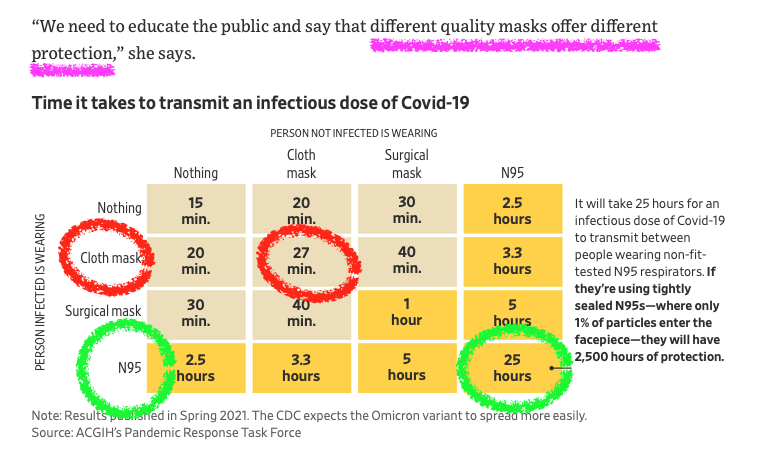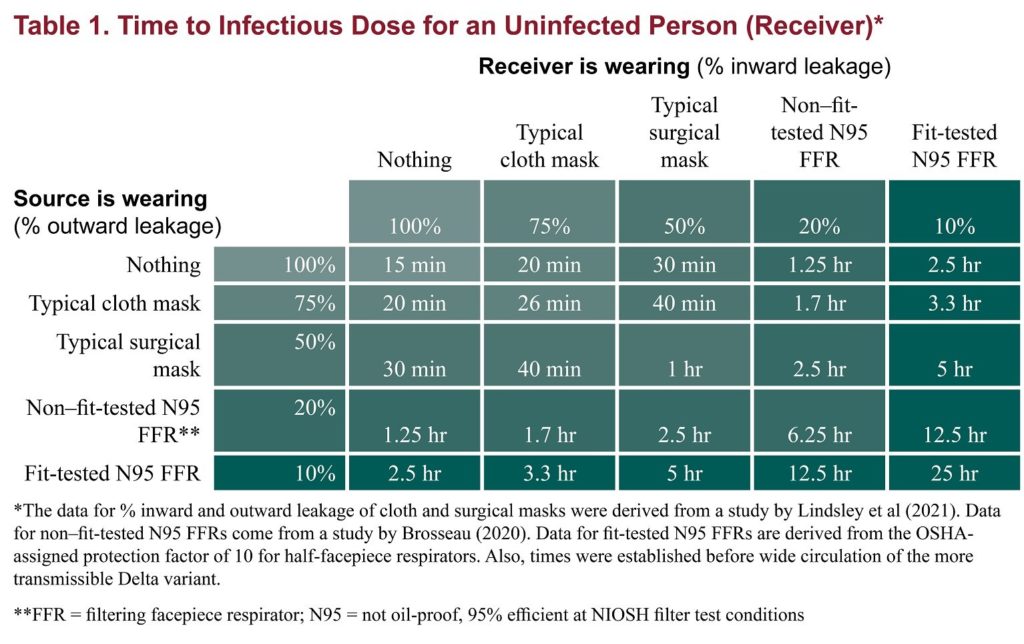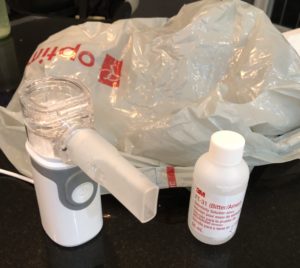
In 2020 and 2021 we wore masks. In 2022 we will be wearing respirators. Whether they're official NIOSH N95s, CAN95, or KN95 , for the purpose of general public use we can just call them "N95s".
The need for N95s has been clear from the beginning of the pandemic, but for two years most of us who masked up made due with cloth or blue surgical masks. Why? At first it was because of an undisputable shortage of stock but also because medical authorities had an overly rigid view of what airborne designations meant. But even when local and international stock became plentiful, various actors actively or passively discouraged their use in both medical and non-medical environments. You see the active discouragement in hospitals and school boards and elsewhere.

It's now January, 2022 and the evidence keeps mounting that N95s are better and the calls to action are getting louder and louder.
The arguments against N95s are bizarre and persistent. The myths persist but are easily proven false, starting with a ground-breaking peer-reviewed paper by Dr. Raina MacIntyre in 2013. In fits of epistemic gatekeeping, the WHO and the medical community have dismissed decades of engineering and applied science studies and practice with respect to respirators and PPE. In a nutshell: engineers and tradespeople use N95s because they work, but many MDs won't believe them without impossible randomized control trials. The IPAC continues, in December 2021, to cast doubt on their effectiveness ("The body of existing evidence comparing N95 respirators (or equivalent) to surgical/procedural (medical) masks has substantial limitations related to high risk of bias and unmeasured confounding. This evidence does not currently support a significant protective effect of N95 respirator use over medical masks"), as does the director of the CDC. The Ontario CMOH successfully argued in court to make N95 usage impractical and ineffective.
However, my eight-year-old daughter, who has used cloth, surgical and N95-class respirators in a variety of settings has more sense than IPAC and the CDC combined. She defaults to using CA-N95s and can perform a common sense fit test all by herself. These N95-class masks are more comfortable for all-day usage than cloth or surgical masks and have been shown to be effective with even the amateur fit testing that even a child can carry out. Cynical "equity" issues have been raised in bureaucratic double-speak against both N95s and HEPA. My wife really likes the CAN99 from Vitacore and finds that it easy to put on properly and she finds it more comfortable than some of the others she's worn. What's important is that she found a respirator that she's more likely to continue to wear because it feels good to her.

The same people who argue that N95s should be fit-tested ignore that fact that nobody is fit-testing their cloth or surgical mask. And even if they did, those inferior masks would fail the fit test without a mask brace. The reality is that we're doing the best we can and many of us would do better if the messaging and methods on mask self-checks were straight-forward. Start with informing the public that they should obtain different models and different sizes to see what fits best on their faces: if you have a small face, try to get a smaller or medium sized respirator. Got a larger face? Get a larger mask. Kid? There are kid-sized respirators, like the CAN99e and CA-N95 KIDS.
I think that the reason for so much push-back against N95s is simple: institutional responsibility, liability and cost. N95s pre-date COVID and their use and effectiveness is well-established. As OHS Canada states: "The Canadian Standards Association’s Z94.4 standard and provincial regulations for health-care and residential facilities, industrial establishments, and construction sites requires that all workers pass a fit test before wearing a respirator for the first time. Users of tight-fitting respirators require fit testing every two years or sooner. A corporate respirator protection program must clarify protections available, should another wave of COVID-19 or another infectious disease strike." The training, procurement, deployment, fit-testing and usage of N95s have long been baked into the business models for construction and other industrial companies. Not so for schools, universities and accounting firms -- at least not at the ubiquitous scale that is required for COVID. Likewise for the liability models. The push-back against N95s during COVID is reminiscent of the pushback against their use during SARS.
For two years, the push-back against N95s has been intense because the use of N95s has long been relegated to dangerous situations that are typically covered by workplace health and safety protocols. This is a key fact to understand because this is also a big legal domain, one in which employers can be found liable for not protecting their employees if they don't spend money to equip and train them.

In spite of political and commercial push-back, scientists and engineers have been beating the N95 drums since 2021 and the drum beat has gotten louder and louder as the evidence piled up, higher and higher. Thankfully, our local and overseas PPE manufacturers have ramped up production, both in terms of quantity and in terms of variety. We have NIOSH-certified N95s coming out of the US, CA-N95 and CAN99 in Canada, and varieties for children, too! (e.g. CanadaMASQ, Vitacore and Eclipse models for kids)
Last month, on December 24th, 2021, I went to get my 3rd vaccine dose and noticed something remarkable: between one third and one half of everyone in the vaccination clinic was wearing N95s. This is in stark contrast to my first two vaccine doses in mid-2021 when I was one of the only ones. Even the Ontario Science Table is starting to budge on N95s.
The general public is starting to get it: they can and should use N95s. The tide is turning. You can find reviews on them on YouTube by people like Aaron Collins (including a review/test on the Vitacore model). It's time to focus on making distribution more equitable and to educate people on common sense "self-seal checks". Want to perform a DIY qualitative fit test similar to the official, professional ones? You can do it at home with a few easy-to-use tools.
Ignore the nay-sayers. N95s are the way to go. What's important is finding the right one for you -- one that you'll be able to afford, find comfortable and that will match the activities that you're trying to get day every day. Let's push for governments, schools and employers to supply them to everyone, because the sooner everyone is wearing a better respirator the sooner we'll be able to defeat COVID.

Conclusion: practice for the best fit possible
Get an N95 respirator. Get a few different types. Try a NIOSH N95 from 3M. Try a CanadaMasq or Vitacore model. Try small, medium and large. Get kid masks and adult masks. Try them out. Perform the best self fit test you can. The more practice you have doing it, the better off you -- and everyone else -- will be.
Fitting your mask: How-To's
There are lots of masks on the market. Try to get different types and see which ones fit your face best. Here is a list of options from Aaron Collins. Next, check out these videos and help pages for fitting:
- Quick fit "blink" test: https://uw-media.coloradoan.com/embed/video/6533993001
- Vitacore's CAN 99 example video.
- NGHAmedia's 3M N95 donning and seal check example video.
- Longer OSHA qualitative fit test example video from FACS.
- Fit-testing a Dentec elastomeric P100 respirator with a quantitative "portacount" machine.
- Eclipse Innovation sells N95-class respirators and offers two videos to show how to put on ("don") and self-test the seal: Horizontal model and vertical model videos.
- "Mask Fit Matters" from the COVID Action Group (Winter/Spring 2022) [update Feb 16, 2022]
- Fit testing with Sweet n' Low (twitter thread; YouTube video)
Video by Dr. Raina MacIntrye from 2014.

James Andrew Smith is a Professional Engineer and Associate Professor in the Electrical Engineering and Computer Science Department of York University's Lassonde School, with degrees in Electrical and Mechanical Engineering from the University of Alberta and McGill University. Previously a program director in biomedical engineering, his research background spans robotics, locomotion, human birth and engineering education. While on sabbatical in 2018-19 with his wife and kids he lived in Strasbourg, France and he taught at the INSA Strasbourg and Hochschule Karlsruhe and wrote about his personal and professional perspectives. James is a proponent of using social media to advocate for justice, equity, diversity and inclusion as well as evidence-based applications of research in the public sphere. You can find him on Twitter. Originally from Québec City, he now lives in Toronto, Canada.
Note: I am not an HVAC or PPE expert. While I have an engineering background (degrees in both EE and MecE) and have done work in Biomedical Engineering, I am not formally trained in either HVAC or PPE. If you're looking for professional design or testing advice or services, please hire a professional engineer who is an expert in the area of interest.
Conflicts of interest: none. I do not work for or have financial interest in any PPE or HVAC company. While I have communicated with companies and employees at PPE and HVAC companies, I do not work for any nor have I received money or contracts from them. All products that I have received were paid for either personally or through my employer or were acquired through friends or family (none of which work for a PPE or HVAC company to my knowledge) -- none have been donated or loaned by manufacturers, suppliers or distributors.
